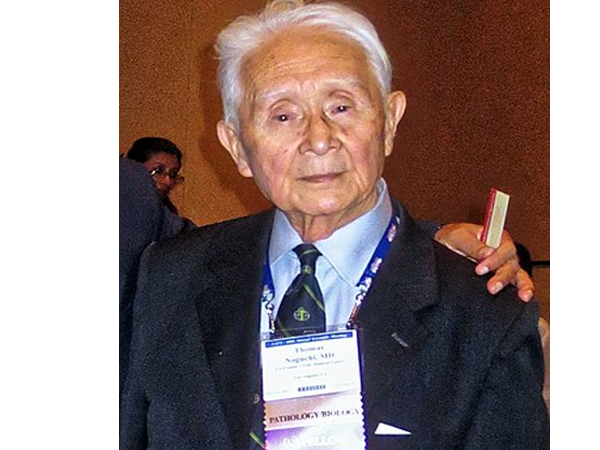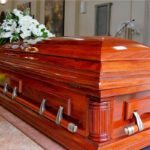
The most famous coroner on earth may well be Dr. Thomas Tsunetomi Noguchi, who was born on January 4, 1927, in Fukuoka, Japan, and was chief medical examiner for Los Angeles County from 1967 to 1982. Presently, he is 96 years old. “I don’t just plan to live until I’m 100,” he told one journalist. “I plan to work until I’m 100.”
Dr. Noguchi was known as the “Coroner to the Stars.” Meaning the stars of Hollywood. And by this point, he has become one of them himself. His name came up again earlier this week in an article about the actor Matthew Perry’s death. The untimely death had fans from across the world calling the Los Angeles County coroner’s office in the middle of the night to check on the cause of death after the 54-year-old, who had struggled with addiction, was found unresponsive in a hot tub.
The Los Angeles County’s Department of Medical Examiner, as the New York Times recently reported, is unique in the world. “Its workload and unique terrain are unparalleled, spanning 88 cities across 4,000 square miles in the nation’s most populous county,” the paper stated. “The office must deal with the same tragic notes as any area — traffic accidents, homicides, drug overdoses, suicides — but also earthquakes, wildfires and riots.” And there is no one who has drawn more attention to that post than Dr. Thomas Noguchi.
Dr. Noguchi studied medicine at the Nippon Medical School in Tokyo from 1944 through 1951. He did his residency at Tokyo University Hospital, then emigrated to California, where he became a resident in pathology at Orange County General Hospital. In 1962, Dr. Noguchi joined the Los Angeles County coroner’s office and rose quickly; in 1967, he was appointed Los Angeles County Coroner.
“The jurisdiction of the coroner’s office is death,” reads a column on the site Nippon.com. “Each day, the office’s medical examiners and coroners dispatch such duties as performing autopsies to determine cause of death, investigating possible crime scenes, issuing death certificates, and transporting bodies to funeral homes.” But when your clientele includes some of the most famous people on the planet, all of these tasks take on a specifically charged character.
In 1969, the county supervisors dismissed Dr. Noguchi after accusing him of trying to use his job to gain personal fame. There were other reputed transgressions, noted the New York Times, including the assertion that he had said he had prayed for the crash of a jumbo jet so that his staff could show how good it was.
Dr. Noguchi refused to leave, however. After a stormy six-week hearing and a petition drive organized by Los Angeles’s Japanese-American community, the County Civil Service Commission overturned the supervisors’ decision, and Dr. Noguchi got his job back. His own fame continued to increase, and the controversies did too. One particularly notable case was the death of the actor John Belushi, who died March 5, 1982. In this instance, Dr. Noguchi received attention simply because he was trying to shun attention.
“Dr. Noguchi was uncharacteristically silent about the actor’s death, apparently because he was heeding an order from the Los Angeles County Board of Supervisors in January to restrain his public comments about the deaths of famous people,” the New York Times reported in an article the following week.
But in the end, Dr. Noguchi did get his moment in the media spotlight regarding Belushi. “Finally, six days after Mr. Belushi’s death,” the New York Times story continued, Dr. Noguchi, typically fond of holding large press conferences, “issued a three-sentence statement…saying the actor had died of an overdose of heroin and cocaine. He refused to return reporters’ telephone calls regarding the statement.”
Dr. Noguchi did other famous autopsies, including the singer Janis Joplin, who died in 1970 at the age of 27 from a suspected drug overdose; the actress Natalie Wood, who drowned near Catalina Island; and Sharon Tate, the young actress and wife of Roman Polanski who was murdered by the Manson Family. Dr. Noguchi also performed the autopsy on Robert F. Kennedy, who was shot to death at the Ambassador Hotel in Los Angeles. Despite calls to move the body back to Washington, Dr. Noguchi’s office conducted a six-and-a-half-hour postmortem examination.
But his most notable case was surely Marilyn Monroe, whose postmortem examination he conducted while still deputy coroner in 1962. Her death has remained controversial for decades, and Dr. Noguchi’s findings have been meticulously scrutinized, pondered upon, and expounded upon. The retired coroner is often pretty mum on the topic, but the Japanese journalist Yamada Toshihiro received unprecedented access in researching his book, Hariuddo kenshi fairu: Tōmasu Noguchi no yuigon. Or in English, Hollywood Inquest Files: The Final Testament of Thomas Noguchi. (Noguchi also published books of his own, including his classic, Coroner, in 1983). “I want this to be my last word on the subject,” Dr. Noguchi told Toshihiro, then the veteran coroner delved into his incredible story.
Dr. Noguchi was still relatively new on the job as Los Angeles County deputy that Sunday morning, August 5, 1962. He reported for work as usual and found an astonishing message on his desk from the chief examiner: “Dr. Curphey wants Dr. Noguchi to do the autopsy on Marilyn Monroe.” Monroe, age 36, had been found dead at her Los Angeles home the previous evening, lying naked, face down, with her right hand gripping the telephone receiver. Bottles containing sleeping pills were found on a bedside table.
“After skimming through the report from the investigator who had dealt with the body, he went straight to the autopsy room,” Toshihiro relays. “He stood in front of the stainless steel table and lifted the white sheet. Dr. Noguchi can still recall vividly how she looked at the end. For a moment, he found it difficult to breathe. The film star Marilyn Monroe was lying there naked in front of him. Even in death, she was beautiful.”
But Toshihiro went even further in his interview with Dr. Noguchi. The coroner went into the gritty details of the procedure. “He began the autopsy with an external examination, proceeding slowly and methodically from the face and neck to the chest, upper arms, and abdomen, inspecting the entire body for the smallest trace of blood or other clues,” says Toshihiro. “Next, Noguchi took a scalpel and made a Y-shaped incision to open up the torso. He removed the internal organs for inspection one by one but found nothing out of the ordinary. He gave the digestive organs particularly close scrutiny, as it was believed that Monroe had taken sleeping pills, but he found no residue in the stomach.”
“When a naked woman is found dead in suspicious circumstances, it is important to examine the victim to determine whether sexual intercourse has taken place,” Toshihiro continues. “Such cases often involve sexual assault, and celebrities are no exception. However, a genital examination revealed no signs of intercourse. The toxicology tests performed on blood collected during the autopsy ultimately revealed the direct cause of death. They found levels of sleeping medication well in excess of the lethal dose. After further investigation at and around the scene, Dr. Noguchi and the coroner’s office concluded that Monroe’s cause of death was ‘acute barbiturate poisoning’ due to ‘ingestion of overdose,’ and that it was a ‘probable suicide.’” Nevertheless, conspiracy theories surrounding Marilyn Monroe’s death continue to this day.
After John Belushi’s death in March 1982, the Los Angeles County supervisors held private meetings to discuss a move to dismiss Dr. Noguchi. A critical report on his performance had just been made public that laid out a coroner’s office plagued by absenteeism, poor management, and lax control of evidence. Later that year, he was demoted from coroner to physician specialist.
The Japanese journalist Yamada Toshihiro interviewed Dr. Noguchi nine years ago, at the age of 87. He was serving as a professor emeritus at the University of Southern California and president of the World Association for Medical Law.
“I don’t just plan to live until I’m 100,” he told Toshihiro at the time. “I plan to work until I’m 100.”









